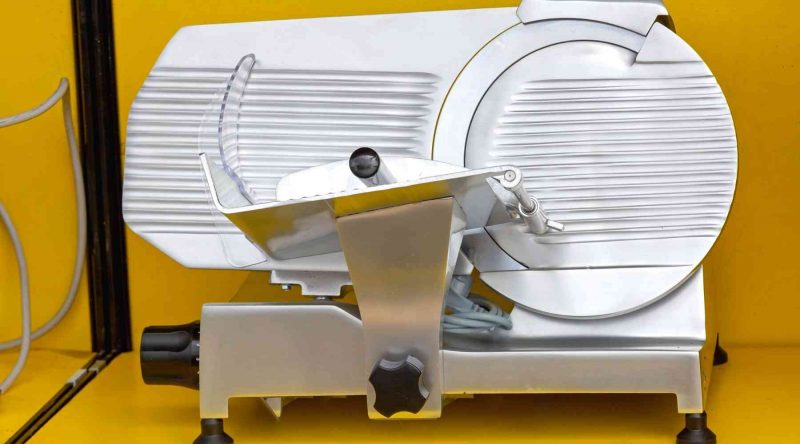If you have one, then you need to know how to clean a meat slicer. Metal slicers and meat slice blades need to be cleaned after every use, or else the blades can dull and the residue can clog up the cogs and gears inside. A dirty meat slicer is not only unsanitary but also dangerous as it won’t cut as efficiently.
If you don’t currently own a meat slicer, you’re missing out! Check out these meat slicer reviews for help picking the best option!
So we put together this comprehensive guide on how to clean a meat slicer. We will cover the different parts of meat slicers and how to remove food buildup and blade damage. Let’s get started.
Why Clean Your Meat Slicer?
Metal slicers need to be cleaned after every use. Here are some major reasons why.
Foodborne illness. Meat slicers build up meat residue, which can be a breeding ground for bacteria and other foodborne illnesses. There have been several foodborne illness outbreaks that have been associated with poorly cleaned meat slicers at local delis. Meat slicers have a lot of grooves and slots where gunk can build up, so you need to clean them thoroughly before storing them.
Maintain equipment. Failing to clean your meat slicer can also affect its performance. Meat slicer parts are designed to fit together very precisely. Allowing grease build-up or gristle can keep these parts from moving together smoothly. Also, grease can damage plastic and metal parts by causing corrosion. Lastly, grease can dull meat slicer blades if they are not cleaned often.
Health inspections. All registered restaurants or delis have to operate by strict food and health codes. While not particularly common, surprise inspections are a thing. You do not want to be caught with a dirty meat slicer. So getting into a regular cleaning routine will keep you safe from any surprise health inspector visits.

Before Cleaning Your Meat Slicer
Before cleaning your meat slicer, consider the following points.
- Always wear cut-resistant gloves when dealing with meat slicer parts, even the parts that do not have blades. They are large machines and you do not want to get your fingers caught between metal parts.
- Make sure you understand how to completely take your meat slicer apart and how the pieces go back together. You do not want to disassemble things and not know how to put them back together. Try to find the manual for instructions on how to take the device apart.
- Check the instruction manual to make sure there are no cleaning materials you should use. For example, some meat slicers recommend you do not use bleach to clean them.
- Unplug all cords if it is an electric meat slicer. You do not want to accidentally turn it on while trying to disassemble the blade case.
- Make sure you know problem areas where grease accumulates. Common problem areas on a meat slicer include the ring guard mount, blade guard, slicer handle, and any other part that makes regular contact with raw and cooked meats.
- Never put your meat slicer in a dishwasher or submerge it in water, unless the manual specifically states that you can do that. Most meat slicers are not made to be completely submerged in water and doing so can damage any electrical components. Blades and other solid metal pieces can be put underwater.
How to Clean a Meat Slicer: Step-by-Step
1. Disconnect All Power
Remove all power cords from outlets and unplug them from the machine. Double check to make sure all power is disconnected and you cannot turn the machine on. If your machine has one, engage the lock just in case.
2. Set the thickness to zero.
Most meat slicer models let you change the thickness by turning a knob on the face of the machine. Make sure that the blade is resting against the plate and is fully down to prevent you from cutting your fingers when moving things around.
3. Clean Away Large Residue
Gently wipe down the blade and surrounding areas to remove any large food particles or residue. Use a soft cloth, rag, paper towel, or gentle scrub pad. Don’t use steel wool on your meat slicer as this can cause scratches and damage the blade.
4. Disassemble the Blade Case and Sanitize
Start to disassemble the machine by taking apart the blade case, food chute, blade guard, and knife sharpener. Remove these parts and let them sanitize in your 3-compartment sink. Let these pieces air-dry afterward. Again, do not scrub them using steel wool as that can scratch and tarnish blade cases and guards.
5. Brush the Exterior of the Case
Using a small brush, start to clean the exterior of the machine. Make sure that you get into all the grooves and crevasses left after you remove the blade unit and guards. Brush the screws, seams, handles, knobs, and other parts that have ridges where food particles and residue can collect. Use a soft bristle brush or else you can damage the case.
6. Remove the Blade
If your machine has a blade removal tool, use it now to remove the blade from the plate. That way, you will be able to clean all around the back of the blade. If your machine does not have a blade removal tool, then just make sure you are thorough when you clean the blade. You can clean the blade thoroughly by running a clean cloth or paper towel between the blade and guard. Work the towel or cloth around the backside by pulling on the ends. Be very careful when feeding the cloth through the blade so you don’t cut your fingers.
7. Wash the Slicer
After removing the blade and cleaning it, take another clean towel and spray a food-safe cleaning solution on it. Run over the machine again, including the parts you scrubbed earlier with a brush. This second pass will ensure that you get all the food residue and particles off the slicer.
8. Rinse the Slicer
Next, gently rinse the slicer in water and dry it off with a clean towel. Do not submerge the slicer. Gently run water over it using your kitchen faucet. Once the slicer is rinsed, thoroughly dry it with a clean towel. Leaving water can cause spotting and might facilitate bacterial growth.
9. Sanitize
After the slicer is dry, spray it with a sanitizer solution on all parts. You can make a simple solution of bleach and water in a spray bottle to sanitize parts. Make sure you only use a small amount of bleach as highly concentrated bleach can damage stainless steel and other common metals used in meat slicers.
10. Allow it to Dry and Reassemble
After sanitizing, let the pieces air dry and then put the machine back together. Make sure that you put the blade case and guard rings back together correctly. Consult the user’s manual if you have any difficulties putting things back together.
11. Cover and Store
After the slicer has been put together, place a cover over it or store it in a cool, dry place. You should not store your meat slicer next to any open food sources or places that are exposed to water vapor.
Meat Slicer Cleaning Tips
- We said it before but it’s worth repeating: Never use steel wool or a similarly abrasive material to clean your meat slicer. Steel wool can cause scratching and abrasions
- Make sure that you use warm or hot water to clean and rinse your slicer. Hot water mixes better with a cleaning solution and can remove tougher food buildup.
- Bleach is by far the best common household chemical that can be used to make sanitizing spray. Make sure that you dilute the bleach with water first before applying.
- If your machine requires it, apply lubrication after you reassemble it after cleaning.
- You need to do a deep clean on your meat slicer at the end of every day before you close up shop.
- You should never use a pressure washer or other high-pressure water device on your meat slicer. Large volumes of water can cause interior damage.
How Can I Maintain My Meat Slicer Blade?
In addition to regular deep cleaning, you should do light spot cleaning after every major use. Frequently clean the blade and make sure you sharpen it with a special stone for sharpening meat slicer blades.
You may also need to have your meat slicer serviced by a professional. Most instruction manuals have recommendations for how often you should get your meat slicer serviced. Failing to get your meat slicer service can lower its operating lifespan and could void any warranties depending on the model.
Final Thoughts on Keeping Your Meat Slicer Clean
Meat slices are practically a necessity in any deli setting, or even in a home kitchen that just loves sliced meats. Like any kitchen tool, meat slicers need to be regularly serviced to maintain their integrity. So, if you own a meat slicer, make sure that you clean it regularly. Regular cleaning can protect you from foodborne illness and keep your equipment in tiptop shape so endless meat slicing.
